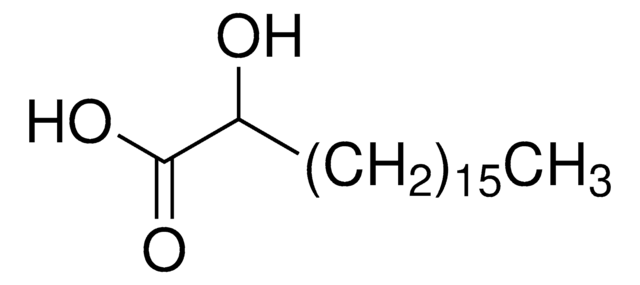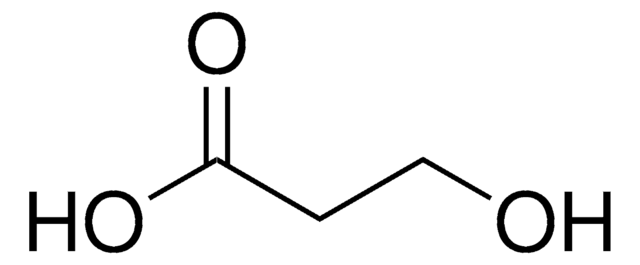Alle Fotos(1)
Wichtige Dokumente
H4398
DL-β-Hydroxy-palmitinsäure
≥98%
Synonym(e):
3-Hydroxy-hexadecansäure
Anmeldenzur Ansicht organisationsspezifischer und vertraglich vereinbarter Preise
Alle Fotos(1)
About This Item
Empirische Formel (Hill-System):
C16H32O3
CAS-Nummer:
Molekulargewicht:
272.42
MDL-Nummer:
UNSPSC-Code:
12352211
PubChem Substanz-ID:
NACRES:
NA.25
Empfohlene Produkte
Qualitätsniveau
Assay
≥98%
Form
powder
Funktionelle Gruppe
carboxylic acid
Lipid-Typ
saturated FAs
Versandbedingung
ambient
Lagertemp.
2-8°C
SMILES String
CCCCCCCCCCCCCC(O)CC(O)=O
InChI
1S/C16H32O3/c1-2-3-4-5-6-7-8-9-10-11-12-13-15(17)14-16(18)19/h15,17H,2-14H2,1H3,(H,18,19)
InChIKey
CBWALJHXHCJYTE-UHFFFAOYSA-N
Biochem./physiol. Wirkung
DL-β-Hydroxypalmitic acid is a mixture of D- and L-β-hydroxypalmitic (3-hydroxyhexadecanoic) acids. 3-hydroxyhexadecanoic [C16:0(3-OH)] may be used in studies that involve the lipid structures of endotoxin lipid A molecules.
Lagerklassenschlüssel
11 - Combustible Solids
WGK
WGK 3
Flammpunkt (°F)
Not applicable
Flammpunkt (°C)
Not applicable
Persönliche Schutzausrüstung
Eyeshields, Gloves, type N95 (US)
Hier finden Sie alle aktuellen Versionen:
Besitzen Sie dieses Produkt bereits?
In der Dokumentenbibliothek finden Sie die Dokumentation zu den Produkten, die Sie kürzlich erworben haben.
Kunden haben sich ebenfalls angesehen
R P Garg et al.
Molecular microbiology, 38(2), 359-367 (2000-11-09)
In the phytopathogen Ralstonia (Pseudomonas) solanacearum, control of many virulence genes is partly mediated by the Phc cell density sensing system. Phc uses a novel self-produced signal molecule [3-hydroxypalmitic acid methyl ester (3-OH PAME)], an atypical two-component system (PhcS/PhcR), and
P Vadovic et al.
Acta virologica, 51(4), 249-259 (2008-01-17)
The composition and structure of lipid A isolated from the lipopolysaccharide (LPS) of Piscirickettsia salmonis were investigated by chemical analyses, gas chromatography/mass spectrometry (GCMS), and electrospray ionization (ESI) combined with the tandem mass spectrometry (MS/MS). Our study revealed moderate compositional
A Fjellbirkeland et al.
Archives of microbiology, 168(2), 128-135 (1997-08-01)
Membranes obtained from whole-cell lysates of Methylococcus capsulatus (Bath) were separated by Triton X-100 extraction. The resulting insoluble fraction was enriched in outer membranes as assessed by electron microscopy and by the content of beta-hydroxy palmitic acid and particulate methane
Paul J Brett et al.
Molecular microbiology, 63(2), 379-390 (2006-12-14)
Burkholderia mallei, the aetiologic agent of glanders, causes a variety of illnesses in animals and humans ranging from occult infections to acute fulminating septicaemias. To better understand the role of lipopolysaccharide (LPS) in the pathogenesis of these diseases, studies were
M Shinohara et al.
Journal of applied microbiology, 103(1), 152-162 (2007-06-23)
To screen novel micro-organisms and enzymes capable of degrading 3-hydroxypalmitic acid methyl ester (3-OH PAME), the quorum-sensing signal molecule (quormone), which regulates the virulence of Ralstonia solanacearum. Ideonella sp. 0-0013, a betaproteobacterium isolated from soil using the selective-enrichment culture method
Unser Team von Wissenschaftlern verfügt über Erfahrung in allen Forschungsbereichen einschließlich Life Science, Materialwissenschaften, chemischer Synthese, Chromatographie, Analytik und vielen mehr..
Setzen Sie sich mit dem technischen Dienst in Verbindung.















